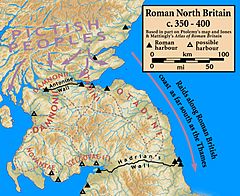Burnswark Hill facts for kids
Burnswark Hill is a famous hill in Scotland, located near the towns of Ecclefechan and Lockerbie. It stands out in the landscape and has a very long and interesting history. For many years, experts have studied the hill to learn about its past.
Recently, a group called the Trimontium Trust has been doing more research. They are helping us understand how the local people and the Roman army interacted here a long, long time ago.
Burnswark Hill was formed by ancient volcanoes over 300 million years ago. This volcanic activity created a perfect spot for an Iron Age hillfort. This hillfort was like a large, protected village, covering about 7 hectares (which is about 10 football fields!).
Besides the Iron Age hillfort, people have found other cool things on the hill. These include a very old Bronze Age burial site, Roman army camps, and even signs of a possible fortlet. There are also remains from the Middle Ages and maybe even a Civil War battery. It's a truly amazing place with a complex and exciting history.
The Roman Siege of Burnswark Hill
The Siege of Burnswark Hill was a big battle for control of this hillfort. It happened between a local Scottish tribe called the Selgovae and the powerful Roman Empire. The Romans were trying to conquer the Scottish Lowlands, and this battle was a key part of their plan. It took place near present-day Burnswark, and the Romans won.
We don't have many old writings that describe the battle itself. However, we know a lot about the time period it happened in. Most of what we know about the battle, like where the soldiers were positioned, comes from archaeological digs at the site.
Quick facts for kids Siege of Burnswark |
|||||||
|---|---|---|---|---|---|---|---|
| Part of Roman conquest of Britain | |||||||
 Scotland in 150 AD |
|||||||
|
|||||||
| Belligerents | |||||||
| Roman Empire | Selgovae | ||||||
| Commanders and leaders | |||||||
| Antoninus Augustus Pius Quintus Lollius Urbicus |
Unknown | ||||||
| Strength | |||||||
| 6,000+ | Unknown | ||||||
| Casualties and losses | |||||||
| Unknown | Unknown, suspected massacre | ||||||
After Emperor Hadrian died, Antoninus Pius became the new Roman Emperor. He quickly decided to expand the Roman Empire's borders. In 139 AD, his army defeated a tribe called the Brigantes. Then, Antoninus Pius ordered Quintus Lollius Urbicus, the Roman Governor of Britain, to march north.
Lollius Urbicus's mission was to conquer the Scottish Lowlands, which were home to tribes like the Otadini, Selgovae, Damnonii, and Novantae. He wanted to push the Roman frontier even further north than Hadrian's Wall.
The Roman Governor moved three large groups of soldiers, called legions, into position. These legions were the Legio II Augusta, Legio VI Victrix, and Legio XX Valeria Victrix. By 140 AD, he had an army of at least 16,500 soldiers north of Hadrian's Wall.
The Selgovae tribe lived in the areas that are now Kirkcudbrightshire and Dumfriesshire. They were among the first tribes to face Lollius Urbicus's army. The Romans were very good at fighting in hilly areas. They quickly took control of high ground and important locations. Some of these spots already had hill forts built by the local tribes.
One such important hill fort was at Burnswark. It was in a great location, controlling the main route further north into Scotland.
How the Battle Happened
The Roman army surrounded the hill fort at Burnswark. They set up two large camps on either side of the fort. This helped them cut off the fort and stop anyone from getting in or out. It's thought that about 6,000 Roman soldiers, including legions and other troops, were in these camps.
The people defending the hill fort likely had simple weapons, like swords and shields. The Romans, however, had advanced siege weapons. They also used slingers, who could throw stones with deadly accuracy. It's believed that almost all the defenders of the hill fort were wiped out during the battle.
What Happened Next
The Siege of Burnswark was probably just one of many battles during the Roman campaign in the Scottish Lowlands. By 142 AD, the Romans had brought the entire area under their control. They successfully moved their northern border even further, building a new wall called the Antonine Wall.
See also
 In Spanish: Burnswark Hill para niños
In Spanish: Burnswark Hill para niños


